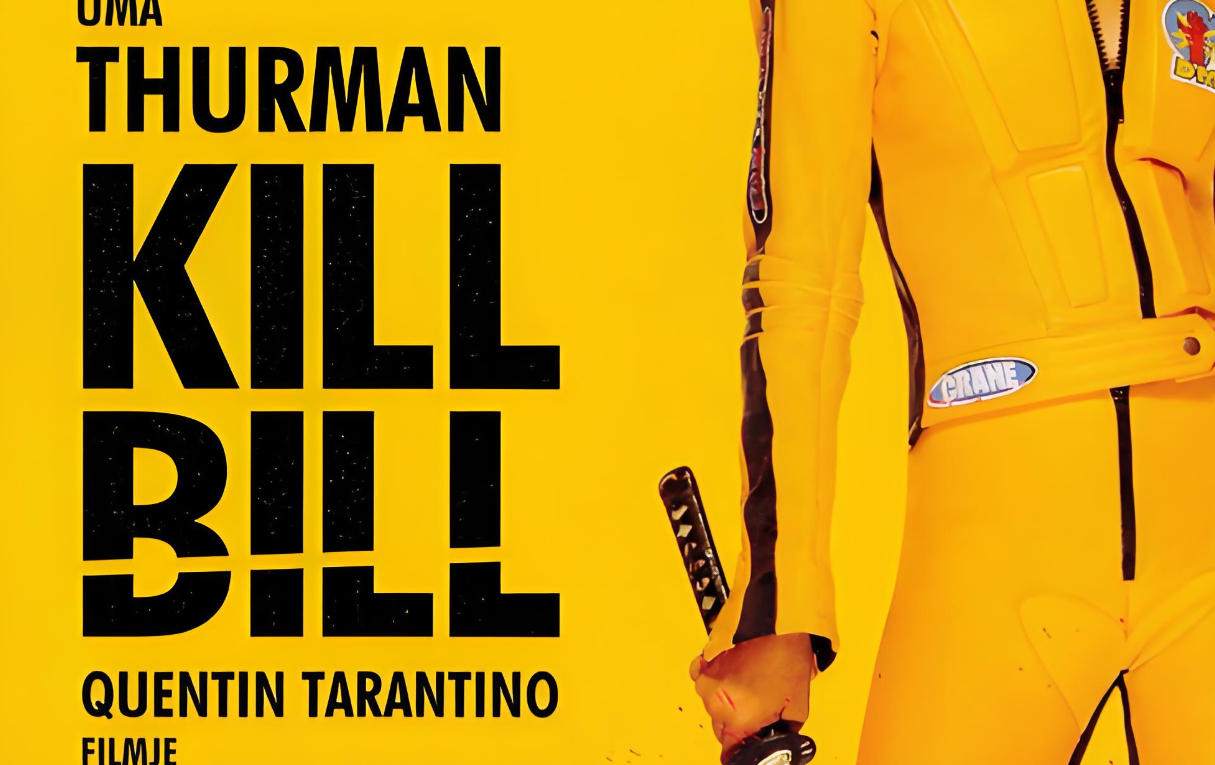เรื่องราวการแก้แค้นของเจ้าสาวและดาบซามูไรใน Kill Bill คืออะไร?

เรื่องราวการแก้แค้นของเจ้าสาวใน Kill Bill คืออะไรกันแน่?
ในภาพยนตร์คลาสสิกของเควนติน แทแรนติโน Kill Bill ได้รับการยกย่องจากแฟนๆ มานานแล้ว ไม่ใช่แค่ภาพยนตร์แอ็คชั่น แต่เป็นภาพอันตระการตาที่ถ่ายทอดถึง การแก้แค้น เกียรติยศ และจิตวิญญาณซามูไร บทความนี้วิเคราะห์ภาพยนตร์จากหลากหลายมุมมอง ทั้ง เนื้อเรื่อง ตัวละครหลัก และอาวุธประจำตัวอย่างดาบ ซามูไร พร้อมทั้งใช้คำสำคัญต่างๆ เช่น 'การวิเคราะห์ภาพยนตร์ Kill Bill,' 'ดาบซามูไร Kill Bill' และ 'ภาพยนตร์คลาสสิกของเควนติน แทแรนติโน' เพื่อช่วยให้แฟนๆ และคนรักภาพยนตร์เข้าใจผลงานชิ้นเอกนี้ได้อย่างลึกซึ้งยิ่งขึ้น
จุดประสงค์ของ Kill Bill คืออะไร?
ความหมายหลักของ Kill Bill สามารถเข้าใจได้หลายมิติ ได้แก่ การแก้แค้น การเติบโตของตัวละคร จิตวิญญาณซามูไร และการเสริมพลังสตรี
1. การแก้แค้นและความยุติธรรม
แก่นเรื่องที่ชัดเจนที่สุดของภาพยนตร์เรื่องนี้คือ การแก้แค้น เบียทริกซ์ คิดโด เจ้าสาวผู้ถูกทรยศอย่างโหดร้ายในงานแต่งงานของเธอและสูญเสียทุกสิ่งทุกอย่าง เธอเลือกที่จะแสวงหาความยุติธรรมในแบบของเธอเอง เรื่องราวทั้งหมดดำเนินไปในรูปแบบเส้นทางแห่งการแก้แค้นอันนองเลือด สะท้อนหลักการ เลือดแลกเลือด ทารันติโนนำเสนอความโหดร้ายและพิธีกรรมแห่งการแก้แค้นผ่านความรุนแรงสุดขั้วและภาพกราฟิกที่จัดจ้าน ทำให้ผู้ชมสัมผัสได้ถึงทั้งความตึงเครียดอันน่าตื่นเต้นและคำถามทางศีลธรรมเกี่ยวกับความยุติธรรมกับการแก้แค้น
2. การเจริญเติบโตของตัวละครและการเปลี่ยนแปลงทางจิตวิทยา
การแก้แค้นไม่ได้หมายถึงแค่การลงโทษผู้อื่นเท่านั้น แต่ยังรวมถึงการไถ่บาปส่วนตัวของเจ้าสาวด้วย สี่ปีแห่งการโคม่าและการสูญเสียคนที่รักได้เปลี่ยนเธอจากเจ้าสาวผู้อ่อนโยนให้กลายเป็นผู้แก้แค้นที่เย็นชาและไร้ความปรานี วิวัฒนาการนี้แสดงให้เห็นถึง ความยืดหยุ่น ความมุ่งมั่น และการเอาชนะตนเอง ทำให้ภาพยนตร์เรื่องนี้มีมิติทางจิตวิทยาและอารมณ์ที่ลึกซึ้งกว่าฉากแอ็คชั่นทั่วไป
3. จิตวิญญาณซามูไรและสัญลักษณ์ทางวัฒนธรรม
ภาพยนตร์เรื่องนี้ผสมผสาน ดาบซามูไร คุณค่าบูชิโด และศิลปะการต่อสู้แบบตะวันออก เข้าด้วยกันอย่างกลมกลืน ซึ่งเป็นสัญลักษณ์ของ ความภักดี เกียรติยศ ความมุ่งมั่น และความเพียรพยายาม ดาบฮัตโตริ ฮันโซเป็นมากกว่าอาวุธ แต่ยังสะท้อนถึงความเชื่อมั่นและความมุ่งมั่นในการแก้แค้นของเจ้าสาว ความเคารพในวัฒนธรรมซามูไรของทารันติโนสร้างสมดุลระหว่างฉากแอ็คชั่นและสุนทรียศาสตร์ได้อย่างลงตัว
4. การเสริมพลังและความเป็นอิสระของผู้หญิง
เจ้าสาวคือหญิงสาวผู้ล้างแค้นผู้โด่งดัง เธอไม่ใช่เหยื่อที่นิ่งเฉย แต่เธอเป็นผู้ควบคุมโชคชะตาของตนเองอย่างแข็งขัน การถ่ายทอดความแข็งแกร่งของผู้หญิงคนนี้ช่วยเพิ่ม ความเป็นอิสระ ความยืดหยุ่น และสติปัญญา ภายใต้ฉากเลือดสาดและความรุนแรงของภาพยนตร์
สรุปแล้ว Kill Bill ไม่ใช่แค่ "หนังแอ็คชั่นล้างแค้น" แต่เป็นภาพยนตร์ที่ผสมผสาน ปรัชญาการล้างแค้น จิตวิญญาณซามูไร การเปลี่ยนแปลงทางจิตวิทยา และการเสริมพลังสตรี ด้วยฉากแอ็กชั่นที่เกินจริง การจัดวางองค์ประกอบอย่างพิถีพิถัน และการอ้างอิงทางวัฒนธรรม ทารันติโนได้ผสมผสานการล้างแค้น เกียรติยศ และสุนทรียศาสตร์ทางศิลปะเข้าด้วยกัน จนกลายเป็นภาพยนตร์คลาสสิกเหนือกาลเวลาสำหรับแฟนๆ
เนื้อเรื่อง: การเดินทางแห่งการแก้แค้นที่นองเลือด
Kill Bill นำเสนอเรื่องราวการแก้แค้นที่ตรงไปตรงมา และเรื่องราวเชิงเส้นตรงนี้เองที่ทำให้ภาพยนตร์เรื่องนี้เต็มไปด้วยความตึงเครียดและพิธีกรรม เจ้าสาว (รับบทโดย อูมา เธอร์แมน) เคยมีชีวิตสมรสและครอบครัวที่มีความสุข แต่วันแต่งงานของเธอกลับกลายเป็นการสังหารหมู่โดยอดีตเพื่อนร่วมรบ หน่วยสังหารไวเปอร์เดดลี เธอได้รับบาดเจ็บสาหัสและตกอยู่ในอาการโคม่านานถึงสี่ปี เมื่อเธอตื่นขึ้นมา เธอพบว่าทุกสิ่งทุกอย่างพังทลายลง และตัดสินใจที่จะไม่อ่อนแออีกต่อไป และเริ่มต้นเส้นทางแห่งการแก้แค้นอันนองเลือด
โครงสร้างการเล่าเรื่องของภาพยนตร์ถูกสร้างขึ้นอย่างชาญฉลาด โดยใช้การเล่าเรื่องแบบไม่เป็นเส้นตรงเพื่อให้ผู้ชมสามารถเคลื่อนไหวไปมาระหว่างไทม์ไลน์ต่างๆ ได้ ผู้ชมจะได้เห็นทุกย่างก้าวของการแก้แค้นของเจ้าสาวผ่านภาพย้อนอดีตและฉากแอนิเมชัน พร้อมกับเข้าใจเบื้องหลังและแรงจูงใจของตัวละครแต่ละตัว แนวทางนี้ทำให้ภาพยนตร์เรื่องนี้ไม่ใช่แค่ภาพยนตร์แอ็คชั่นรุนแรง แต่ยังเต็มไปด้วย ความระทึกขวัญทางจิตวิทยาและอารมณ์ที่ลึกซึ้ง
หนึ่งในฉากที่น่าจดจำที่สุดคือฉากดวลกันระหว่างเจ้าสาวกับโอเรน อิชิอิ ฉากนี้เกิดขึ้นในค่ำคืนหิมะอันหนาวเหน็บของโตเกียว ประกอบกับดนตรีประกอบที่ชวนครุ่นคิดและภาพการเคลื่อนไหวช้าๆ ทุกการโจมตีล้วนเต็มไปด้วยความแค้น ทารันติโนผสมผสาน สุนทรียศาสตร์ของดาบซามูไรญี่ปุ่น เข้ากับ การเล่าเรื่องแบบวีรบุรุษผู้โดดเดี่ยวแบบตะวันตกได้ อย่างแนบเนียน สร้างสรรค์เป็นการผสมผสานที่ลงตัวระหว่างความโหดเหี้ยมและการแสดงออกทางศิลปะ ทั้งน่าตื่นเต้นและงดงามตระการตา
ยิ่งไปกว่านั้น การแก้แค้นทุกครั้งในภาพยนตร์เปรียบเสมือนพิธีกรรม ตั้งแต่การไปเยี่ยมชมโรงงานดาบของฮันโซเพื่อครอบครองดาบในตำนาน ไปจนถึงการต่อสู้กับเครซี่ 88 และสุดท้ายคือการเผชิญหน้ากับบิล การต่อสู้แต่ละครั้งล้วนเต็มไปด้วยสัญลักษณ์ การแก้แค้นไม่ได้เกี่ยวกับหนี้เลือดเพียงอย่างเดียว แต่ยังเกี่ยวกับเกียรติยศ ศรัทธา และการแสวงหาคุณค่าแบบบูชิโด อีกด้วย ด้วยเหตุนี้ Kill Bill จึงไม่เพียงแต่ดึงดูดใจแฟนหนังแอ็คชั่นและฉากโหดเท่านั้น แต่ยังดึงดูดใจคอหนังที่ชื่นชอบการวิเคราะห์เรื่องราวและตัวละครอย่างลึกซึ้งอีกด้วย
การพัฒนาตัวละครใน Kill Bill : จุดตัดระหว่างการแก้แค้นอย่างเลือดเย็นและความมุ่งมั่นที่ไม่ย่อท้อ
1. เจ้าสาว – เบียทริกซ์ คิดโด
เบียทริกซ์ คิดโดมีภูมิหลังอันเป็นตำนาน เธอได้รับการฝึกฝนตั้งแต่ยังเด็กจนกลายเป็นสุดยอดนักฆ่า เรียนรู้เทคนิคการต่อสู้และทักษะการใช้ดาบซามูไรหลากหลายรูปแบบจากบิล อาจารย์ผู้เชี่ยวชาญของหน่วยสังหารเดดลี่ไวเปอร์ ประสบการณ์ในวัยเด็กสอนให้เธอรู้จักกับความจริงอันโหดร้ายของการเอาชีวิตรอดและการฆ่า แต่เธอก็ยังคงโหยหาครอบครัวและความรัก
ช่วงต้นเรื่อง เธอกำลังเตรียมตัวทิ้งชีวิตนักฆ่าไว้เบื้องหลังและสร้างครอบครัวกับบิล ทว่า การทรยศหักหลังอันนองเลือดในวันแต่งงานได้ทำลายชีวิตของเธออย่างสิ้นเชิง ประสบการณ์อันน่าเศร้านี้เปลี่ยนเส้นทางแห่งการแก้แค้นของเธอให้กลายเป็นมากกว่าแค่การแก้แค้นผู้อื่น แต่ยังเป็นการเดินทางเพื่อการไถ่บาปส่วนบุคคลอีกด้วย การเติบโตของเธอสะท้อนให้เห็นถึงการเปลี่ยนแปลงอย่างสมบูรณ์ จากความไร้เดียงสาสู่ความมุ่งมั่น จากความอ่อนโยนสู่ความมุ่งมั่นอย่างเลือดเย็น เปี่ยมไปด้วยความเพียรและความอดทนดุจซามูไร
2. บิล (รับบทโดย เดวิด คาร์ราไดน์)
ภูมิหลังของบิลนั้นซับซ้อนและซับซ้อนไม่แพ้กัน เขาเป็นทั้งที่ปรึกษาและผู้ยึดเหนี่ยวจิตใจของเจ้าสาว บิลเกิดในครอบครัวนักฆ่าที่มีวินัยและโหดเหี้ยม เขาได้รับการฝึกฝนอย่างเข้มงวดตั้งแต่ยังเด็ก จนพัฒนาบุคลิกภาพที่สงบ เฉลียวฉลาด และเฉียบคม ด้วยความเชี่ยวชาญในอาวุธและทักษะการต่อสู้หลากหลายชนิด เขายังมีความรู้ความเข้าใจเชิงจิตวิทยาอย่างลึกซึ้ง ทำให้เขากลายเป็นบุคคลสำคัญของหน่วยสังหารไวเปอร์มรณะ
ความสัมพันธ์ระหว่างบิลและเจ้าสาวเป็นทั้งที่ปรึกษาและลูกศิษย์ที่ใกล้ชิดและเปี่ยมไปด้วยอารมณ์ การทรยศหักหลังของเขาเป็นจุดเริ่มต้นของเรื่องราวการแก้แค้นหลักของภาพยนตร์ การเติบโตและประสบการณ์ชีวิตของบิลทำให้เขาเป็นทั้งที่ปรึกษาที่น่าเชื่อถือและตัวละครที่มีความปรารถนาและความเปราะบางแบบมนุษย์ ความแตกต่างนี้ช่วยเพิ่มความลึกซึ้งให้กับตัวละครของเขา ทำให้ผู้ชมได้สัมผัสทั้งความตื่นเต้นเร้าใจของการแก้แค้นและความรุนแรงของความขัดแย้งทางอารมณ์
3. โอเรน อิชิอิ (ชิโฮะ อิชิอิ)
ภูมิหลังของโอเรน อิชิอินั้นน่าเศร้าที่สุด เธอเกิดในครอบครัวลูกครึ่งญี่ปุ่น-จีน แม่ของเธอมาจากครอบครัวยากูซ่าญี่ปุ่น ส่วนพ่อของเธอเป็นปรมาจารย์ศิลปะการต่อสู้ชาวจีน ในวัยเด็ก เธอได้เห็นการฆาตกรรมพ่อแม่ ซึ่งเป็นเหตุการณ์ที่หล่อหลอมบุคลิกที่โหดเหี้ยมของเธอ และเป็นรากฐานที่ทำให้เธอกลายเป็นมือสังหารชั้นยอด
เธอเติบโตมาในโลกใต้ดินของอาชญากร เธอเชี่ยวชาญการต่อสู้เพื่อแย่งชิงอำนาจ ดาบ และทักษะการเอาชีวิตรอด ภูมิหลังของเธอไม่เพียงแต่ทำให้เธอมีความสามารถในการต่อสู้อันน่าทึ่งเท่านั้น แต่ยังทำให้เธอมีสติสัมปชัญญะและความคิดเชิงกลยุทธ์ที่ยอดเยี่ยม ภาพยนตร์เรื่องนี้ใช้ฉากแอนิเมชันเพื่อถ่ายทอดวัยเด็กของเธอ แสดงให้เห็นถึงการเปลี่ยนแปลงของเธอจากเหยื่อสู่อำนาจ ในที่สุดเธอก็กลายเป็นผู้นำของกลุ่ม Crazy 88 และการครองราชย์อันนองเลือดและการดวลครั้งสุดท้ายกับเจ้าสาวได้แสดงให้เห็นถึงบุคลิกที่ซับซ้อนและน่าหลงใหลของเธอ

ดาบซามูไรและจิตวิญญาณซามูไร: จิตวิญญาณแห่งภาพยนตร์
เมื่อพูดถึง Kill Bill เราต้องไม่มองข้าม ดาบฮัตโตริ ฮันโซ สัญลักษณ์แห่งการแก้แค้นและเกียรติยศ ดาบเล่มนี้ไม่เพียงแต่เป็นอาวุธสังหาร แต่ยังเป็นสัญลักษณ์ทางจิตวิญญาณของเรื่องราวการแก้แค้นทั้งหมด เควนติน แทแรนติโน ปฏิบัติต่อดาบฮันโซด้วยความเคารพอย่างสูง สะท้อนถึง ฝีมืออันประณีต คุณค่าของซามูไรแบบดั้งเดิม และความมุ่งมั่นอันแน่วแน่ ซึ่งเหนือกว่าความสำคัญของอาวุธเย็นธรรมดาทั่วไป
ในภาพยนตร์ ดาบซามูไรไม่เพียงแต่ทำหน้าที่เป็นเครื่องมือต่อสู้เท่านั้น แต่ยังเป็นส่วนขยายของจิตวิทยาตัวละครและสัญลักษณ์ทางวัฒนธรรมอีกด้วย
1. บูชิโดและเกียรติยศ
ดาบฮันโซไม่ได้เป็นเพียงสัญลักษณ์แห่งอำนาจ แต่ยังสะท้อนถึงการแสวงหาศรัทธาและความภักดี การโจมตีแต่ละครั้งที่เจ้าสาวใช้ระหว่างการแก้แค้นเปรียบเสมือนการฝึกฝน บูชิโด สมัยใหม่ นั่นคือ ความอดทน ความมุ่งมั่น ความเคารพต่อศัตรู ควบคู่ไปกับการรักษาเกียรติศักดิ์ ในการดวลดาบท่ามกลางหิมะกับโอเรน อิชิอิ การปะทะกันของดาบไม่ได้เป็นเพียงการนองเลือด แต่มันคือการต่อสู้แห่ง ศีลธรรม ความหลงใหล และความเชื่อมั่นในการแก้แค้น ผู้ชมสัมผัสได้ว่าการฟาดฟันทุกครั้งได้ถ่ายทอดอารมณ์ ความเชื่อ และการปลดปล่อยชีวิตที่สูญเสียไปของเจ้าสาว
2. การขยายขอบเขตของสุนทรียศาสตร์แห่งความรุนแรง
ทารันติโนผสมผสานความรุนแรงเข้ากับสุนทรียศาสตร์ได้อย่างยอดเยี่ยม การใช้ดาบฮันโซช่วยเพิ่มความเข้มข้นให้กับฉากแอ็กชัน พร้อมกับให้เลือดสาดกระเซ็นดูมีศิลปะ ตั้งแต่การต่อสู้กับ Crazy 88 ไปจนถึงการเผชิญหน้าครั้งสุดท้ายกับบิล การฟาดฟันดาบแต่ละครั้งได้รับการออกแบบอย่างพิถีพิถันด้วยการเคลื่อนไหวแบบสโลว์โมชัน ภาพโคลสอัพ และคอนทราสต์สี ทำให้ความรุนแรงกลายเป็นบทกวีทางสายตา
นอกจากนี้ การออกแบบดาบและท่วงท่าการต่อสู้ยังสะท้อนถึงสุนทรียศาสตร์ตะวันออก เรียบง่ายแต่เฉียบคม แม่นยำแต่สง่างาม การผสมผสานอย่างลงตัวระหว่างอาวุธเย็นและการเล่าเรื่องการแก้แค้น ทำให้ดาบซามูไรกลายเป็นจิตวิญญาณของภาพยนตร์ ถ่ายทอดทั้งพลังสังหารและความหมายเชิงวัฒนธรรมและจิตวิญญาณอันลึกซึ้ง
3. ดาบในฐานะสัญลักษณ์แห่งการเติบโต
ในภาพยนตร์ ดาบฮันโซยังเป็นสัญลักษณ์ของการเติบโตและการเปลี่ยนแปลงของเจ้าสาว จากความไร้หนทางสู่ความเชี่ยวชาญ เธอไม่เพียงแต่เรียนรู้ที่จะโจมตีศัตรูอย่างแม่นยำเท่านั้น แต่ยังบรรลุถึงการแก้แค้นทางจิตใจและการยกระดับจิตวิญญาณในแต่ละครั้งอีกด้วย ดาบเล่มนี้ผูกพันกับเธออย่างแนบแน่น สะท้อนให้เห็นถึงการแสวงหา คุณค่าในตนเอง ความแข็งแกร่ง และความเชื่อมั่น ของเธอ
หากปราศจากดาบฮันโซ ธีมของการแก้แค้นและจิตวิญญาณซามูไรใน Kill Bill คงไม่สดใสเท่านี้ ดาบฮันโซไม่ได้เป็นเพียงแค่อาวุธ แต่ยังมีแก่นแท้ทางศิลปะและวัฒนธรรมของภาพยนตร์ มอบความลึกซึ้งและน้ำหนักเชิงสัญลักษณ์ให้กับการต่อสู้แต่ละครั้ง
ของสะสมจากภาพยนตร์: ดาบซามูไรระดับไฮเอนด์ที่ตีขึ้นด้วยมือจาก Kill Bill
สำหรับแฟนๆ Kill Bill และนักสะสม ดาบ ดาบญี่ปุ่นคุณภาพสูงตีขึ้นมือ Kill Bill Anniversary Edition Clay Tempered คือสมบัติล้ำค่าที่ไม่ควรพลาด ดาบเล่มนี้ ตีขึ้นมือด้วยเทคนิคดั้งเดิม ใบมีดเหล็กกล้าคาร์บอนสูง ที่ผ่านการชุบแข็งด้วยดินเหนียว ผสานความคม ความทนทาน และความงดงามของลวดลายเหล็กพับ
ด้ามจับหุ้มด้วยหนังกระเบนแท้เพื่อความกระชับมือ และฝักดาบเคลือบสีดำเปียโนก็เรียบเนียนและประณีต ทุกรายละเอียดล้วนเลียนแบบดาบฮันโซอันโด่งดังจากภาพยนตร์ได้อย่างสมจริง นอกจากจะเป็นของสะสมแล้ว ดาบเล่มนี้ยังเป็นการยกย่องจิตวิญญาณแห่งการแก้แค้นและบูชิโดของเจ้าสาว ไม่ว่าจะตั้งโชว์หรือใช้เป็นพร็อพถ่ายภาพ ก็ช่วยให้แฟนๆ ได้สัมผัสกับความเข้มข้นทางภาพและวัฒนธรรมของ Kill Bill
สไตล์อันเป็นเอกลักษณ์ของเควนติน ทารันติโน: การผสมผสานระหว่างความรุนแรงและศิลปะ
เควนติน แทแรนติโน เป็นที่รู้จักจากการผสมผสานองค์ประกอบต่างๆ ของหนังบี หนังซามูไร หนังคาวบอย และหนังกังฟู และเขาได้นำองค์ประกอบเหล่านี้มาผสมผสานกันอย่างเต็มประสิทธิภาพใน Kill Bill เขาสร้างฉากแอ็กชันคลาสสิกขึ้นมาใหม่ พร้อมกับนำเสนอสไตล์ภาพและการเล่าเรื่องที่โดดเด่น ทำให้ทุกเฟรมดูราวกับภาพยนตร์
1. สีและกรอบ: ศิลปะแห่งความรุนแรง
การใช้สีสันของภาพยนตร์เรื่องนี้มีความดราม่าอย่างมาก เลือดสีแดงสดตัดกับพื้นหลังสีขาวราวกับหิมะอย่างโดดเด่น ขณะที่ฉากมืดๆ ที่มีเงาช่วยขับเน้นบรรยากาศอันเย็นชาและเต็มไปด้วยความอาฆาตแค้น การจัดวางฉากของทารันติโนนั้นพิถีพิถัน การต่อสู้แต่ละครั้งเปรียบเสมือนงานศิลปะภาพ ด้วยภาพสโลว์โมชัน ภาพโคลสอัพ และจังหวะที่แม่นยำ
สไตล์นี้ทำให้ฉากรุนแรงน่ารับชมและแสดงให้เห็นถึงปรัชญาของ 'สุนทรียศาสตร์รุนแรง' : เลือดไม่เพียงแต่สร้างความตกตะลึงเท่านั้น แต่ยังเป็นเครื่องมือในการเล่าเรื่องและทางศิลปะ ช่วยให้ผู้ชมสัมผัสได้ถึงทั้งความตึงเครียดทางอารมณ์และความลึกซึ้งทางจิตวิทยา
2. ดนตรีและอารมณ์: จังหวะแห่งการแก้แค้น
การเลือกใช้ดนตรีของทารันติโนนั้นยอดเยี่ยมมาก เพลงประกอบของ Kill Bill ครอบคลุมทั้งดนตรีแจ๊ส ร็อก และท่วงทำนองตะวันออกดั้งเดิม ช่วยเสริมอารมณ์ของแต่ละฉากได้อย่างยอดเยี่ยม ยกตัวอย่างเช่น ดนตรีจังหวะเร็วระหว่างการต่อสู้ Crazy 88 ที่ทำให้ผู้ชมดื่มด่ำ ขณะที่การดวลหิมะกับโอเรน อิชิอิ ก็เต็มไปด้วยจังหวะอันน่าสะพรึงกลัวและอันตราย ดนตรีสอดประสานเข้ากับฉากแอ็กชัน เร่งจังหวะการเล่าเรื่องและความตึงเครียดแบบพิธีกรรมของการแก้แค้น
3. การผสมผสานระหว่างวัฒนธรรมและแนวภาพยนตร์: ภาษาภาพยนตร์ที่เป็นเอกลักษณ์
Kill Bill เป็นมากกว่าหนังแอ็คชั่นล้างแค้น แต่มันคือการผสมผสานระหว่างวัฒนธรรมตะวันออกและตะวันตก ดาบซามูไร กังฟู ความขัดแย้งของมาเฟีย และการเล่าเรื่องแบบฮีโร่เดี่ยวแบบตะวันตก ล้วนผสมผสานกันอย่างลงตัว ฉากแอนิเมชัน เรื่องราวที่ไม่เป็นเส้นตรง และฉากแอ็คชั่นที่เกินจริง ทำให้หนังเรื่องนี้ทั้งสนุกและมีศิลปะ ภาษาภาพยนตร์อันเป็นเอกลักษณ์ของทารันติโนทำให้ผู้ชมเพลิดเพลินไปกับฉากแอ็คชั่นที่รวดเร็ว พร้อมกับสัมผัสถึงความลึกซึ้งทางอารมณ์และวัฒนธรรมเบื้องหลังการล้างแค้น
ด้วยการผสมผสานสีสัน การจัดวางองค์ประกอบ ดนตรี และแนวภาพยนตร์ ทารันติโนจึงเนรมิต Kill Bill ให้เป็นภาพยนตร์ที่ทั้ง ทรงพลังทางภาพและเปี่ยมไปด้วยอารมณ์ ทุกการฟันดาบ ทุกหยดเลือด กลายเป็นมากกว่าแค่องค์ประกอบของแอ็คชั่น แต่มันคือส่วนขยายของศิลปะภาพยนตร์ ตอกย้ำความเป็นภาพยนตร์คลาสสิกที่ไม่อาจทดแทนได้
บทสรุป: ทำไม Kill Bill ถึงคุ้มค่าที่จะดูอีกครั้ง
Kill Bill ไม่ใช่แค่ภาพยนตร์แอ็คชั่นเท่านั้น แต่ยังเป็นมหากาพย์ที่เปี่ยมไปด้วยวัฒนธรรม นำเสนอดาบซามูไรญี่ปุ่น การแก้แค้นของวีรบุรุษผู้โดดเดี่ยวชาวตะวันตก และการผงาดขึ้นของพลังอำนาจหญิง สำหรับคอหนัง ไม่ว่าจะวิเคราะห์ สไตล์การกำกับของทารันติโน หรือเพียงแค่ชื่นชม การออกแบบและการต่อสู้ของดาบซามูไร Kill Bill ภาพยนตร์เรื่องนี้คุ้มค่าแก่การรับชมซ้ำแล้วซ้ำเล่า









